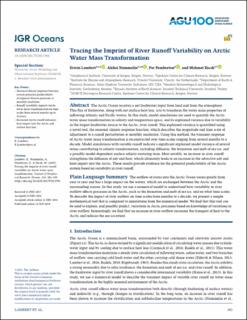| dc.contributor.author | Lambert, Erwin | |
| dc.contributor.author | Nummelin, Aleksi | |
| dc.contributor.author | Pemberton, Per | |
| dc.contributor.author | Ilicak, Mehmet | |
| dc.date.accessioned | 2020-04-01T10:37:58Z | |
| dc.date.available | 2020-04-01T10:37:58Z | |
| dc.date.created | 2019-10-28T12:09:36Z | |
| dc.date.issued | 2019 | |
| dc.identifier.citation | Journal of Geophysical Research (JGR): Space Physics. 2019, 124 (1), 302-319. | |
| dc.identifier.issn | 2169-9380 | |
| dc.identifier.uri | https://hdl.handle.net/11250/2649855 | |
| dc.description.abstract | The Arctic Ocean receives a net freshwater input from land and from the atmosphere. This flux of freshwater, along with net surface heat loss, acts to transform the water mass properties of inflowing Atlantic and Pacific waters. In this study, model simulations are used to quantify the Arctic water mass transformation in salinity and temperature space, and its explained variance due to variability in the largest freshwater source to the Arctic: river runoff. This explained variance is quantified using a novel tool, the seasonal climate response function, which describes the magnitude and time scale of adjustment to a runoff perturbation at monthly resolution. Using this method, the transient response of Arctic water mass transformation is reconstructed over time scales ranging from several months to a decade. Model simulations with variable runoff indicate a significant explained model variance of several terms contributing to salinity transformation, including diffusion, the formation and melt of sea ice, and a possibly model‐dependent surface salinity‐restoring term. Most notably, an increase in river runoff strengthens the diffusion of salt and heat, which ultimately leads to an increase in the advective salt and heat import into the Arctic. These results provide evidence for the potential predictability of the Arctic system based on variability in river runoff. | |
| dc.language.iso | eng | |
| dc.rights | CC BY-NC-ND 4.0 | |
| dc.rights.uri | https://creativecommons.org/licenses/by-nc-nd/4.0/ | |
| dc.title | Tracing the Imprint of River Runoff Variability on Arctic Water Mass Transformation | |
| dc.type | Peer reviewed | |
| dc.type | Journal article | |
| dc.description.version | publishedVersion | |
| cristin.ispublished | true | |
| cristin.fulltext | original | |
| cristin.qualitycode | 2 | |
| dc.identifier.doi | 10.1029/2017JC013704 | |
| dc.identifier.cristin | 1741120 | |
| dc.source.journal | Journal of Geophysical Research (JGR): Space Physics | |
| dc.source.volume | 124 | |
| dc.source.issue | 1 | |
| dc.source.pagenumber | 302-319 | |
| dc.relation.project | Norges forskningsråd: 229763 | |
| dc.relation.project | Nordforsk: 76654 | |

